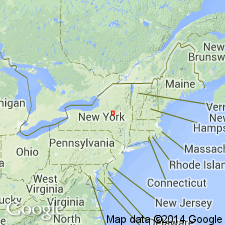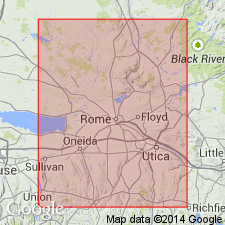
- Usage in publication:
-
- Russia limestone member
- Modifications:
-
- Named
- Dominant lithology:
-
- Limestone
- AAPG geologic province:
-
- Appalachian basin
Summary:
Russia limestone member of Denmark formation defined at Trenton Falls as extending from top of Poland member (new) through 70 ft of shaly limestone to a local disconformity 2 ft below a ferruginous bed in the base of Upper High Falls. Lower 50 ft lithologically similar to the Poland, but relatively barren platy calcilutite and shale form upper 20 ft. Underlies Rust member (new) of Cobourg formation. Age is Middle Ordovician.
Source: GNU records (USGS DDS-6; Reston GNULEX).

- Usage in publication:
-
- Russia Member
- Modifications:
-
- Revised
- AAPG geologic province:
-
- Appalachian basin
Summary:
Authors feel a refined, unified Trenton stratigraphy is essential. Applied here is a modified version of Kay's (1968) stratigraphic nomenclature. Poland Member at the base of Denley Limestone includes the informally named City Brook bed. Russia Member is divided into Wolf Hollow division (with North Gage Road bed at its base), Brayton Corners division, and High Falls division [also called tongue]. Rust Member, uppermost unit of the Denley, remains undivided and underlies Steuben Limestone.
Source: GNU records (USGS DDS-6; Reston GNULEX).
For more information, please contact Nancy Stamm, Geologic Names Committee Secretary.
Asterisk (*) indicates published by U.S. Geological Survey authors.
"No current usage" (†) implies that a name has been abandoned or has fallen into disuse. Former usage and, if known, replacement name given in parentheses ( ).
Slash (/) indicates name conflicts with nomenclatural guidelines (CSN, 1933; ACSN, 1961, 1970; NACSN, 1983, 2005, 2021). May be explained within brackets ([ ]).

